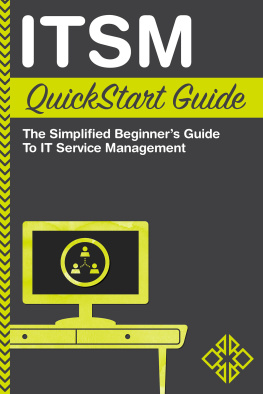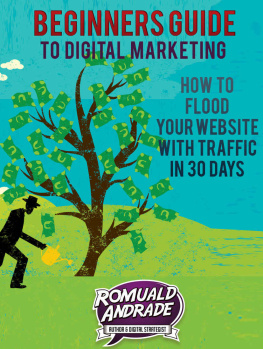Information Technology For Beginners
A beginners guide on the big field of the IT
For all those people who struggle to become digital
Tom Cartelli
Copyright 2021 [Tom Cartelli]
All rights reserved. No part of this guide may be reproduced in any form without permission in writing from the publisher except in the case of brief quotations embodied in critical articles or reviews.
Legal & Disclaimer
The information contained in this book and its contents is not designed to replace or take the place of any form of medical or professional advice; and is not meant to replace the need for independent medical, financial, legal or other professional advice or services, as may be required. The content and information in this book has been provided for educational and entertainment purposes only.
The content and information contained in this book has been compiled from sources deemed reliable, and it is accurate to the best of the Author's knowledge, information and belief. However, the Author cannot guarantee its accuracy and validity and cannot be held liable for any errors and/or omissions. Further, changes are periodically made to this book as and when needed. Where appropriate and/or necessary, you must consult a professional (including but not limited to your doctor, attorney, financial advisor or such other professional advisor) before using any of the suggested remedies, techniques, or information in this book.
Upon using the contents and information contained in this book, you agree to hold harmless the Author from and against any damages, costs, and expenses, including any legal fees potentially resulting from the application of any of the information provided by this book. This disclaimer applies to, any loss, damages or injury caused by the use and application, whether directly or indirectly, of any advice or information presented, whether for breach of contract, tort, negligence, personal injury, criminal intent, or under any other cause of action.
You agree to accept all risks of using the information presented in this book.
You agree that, by continuing to read this book, where appropriate and/or necessary, you shall consult a professional (including but not limited to your doctor, attorney, or financial advisor or such other advisor as needed) before using any of the suggested remedies, techniques, or information in this book.
2 Key Processes to Structure a Successful Technology Migration
Recently, I wrote a piece on a topic on why you should use a tool Called detail negativity. In this article, I talk about the two key processes to a successful technology migration. And why planning the project is key. This article includes a timeline for you to follow, a list of key items, and action items to be completed in a timely manner.
When setting out to accomplish a technology migration, setting up the right infrastructure is key. And many people start off by planning to do the wrong thing, such as bringing in their legacy systems and changing them over, without first ensuring that they know what they are doing.
Using a Workflow and a Toolbox
A workflow is an order system that quantities the work, and tracks its progress. Workflow assimilation also enables a full audit trail of all work done, and a full analysis of the work done, including any problems. Adding in a protocol will help to ensure you catch any problems before moving any further.
Creating the platform for integration
You have to plan for the future after using a service to migrate legacy applications. This is an area where things sometimes go wrong, and you need to be prepared. One of the challenges that we face is that there are lots of small vendors out there. Many of those will not have the required skills to do the job, or will be charging a premium for this service. Others may have some in-house solutions in place, but they may be so far away from your requirements that the in-house employees are very unlikely to be able to do it.
Using a toolbox is a massive project. You need to do your research and pick the toolbox that best suits your team. I would start by looking at the team members. Who can make the most use of the technology? Find out their roles and responsibilities. Will they be using the technology for every business process? Will they still be needed after the migration? Obviously, you can't just migrate your existing systems without adaptation them to your new system. Find out the ages of the technology - It can be difficult to alter a system that is still working in current demand.
I have seen lots of companies try to change their technology without realising just how much effort it is going to take. Sometimes this can even lead to really expensive extra investments.
Modular systems are always a good choice. This choice has many advantages including:
Easy migration. Quicker is definitely better.
Customisation of functionality. No need to change basic processes.
perceive ability. The business can see what it wants. It can't hide its hand.
Control over changes. System not expand automatically.
The IT team must be kept in the loop at all times. Make sure that they are involved in the development and future of the system.
It's not about trusting your vendor and provider of the technology to manage the migration. It's about demanding control over their responsibility.
Remaining in control of the technology change is the most important aspect of a successful technology migration.
A lack of involvement of the IT team in the implementation can be one of the fastest and biggest delays in the project.
The staff may believe that the staff are more productive if they are given more responsibility. If this happened it would result in a new and better product.
Staff may feel that they don't have a choice and must follow the technology change or be content with their current role.
The start of a business does not necessarily indicate the end of its existence. A great company can run over years and still be delivering at a very efficient pace. So don't be afraid to change your company to a bigger or better version of it. It doesn't have to be the best version of itself, but it could be just the perfect fit for your company and your customers. 3 Benefits of Digital Photography Software
Digital photography software is one of the most vital and critical pieces of software to obtain or own. With it, you can do so many things - from taking and viewing photographs to editing them, changing them into something that you might want, converting them into digital files, sharing them, posting them on the web, keeping them tile and much more. Anything that even remotely approaches photography as an art form is on the list, by virtue of its ability to be created.
With photography software, you can take and edit your photos, make them a bit better, upload them onto your computer, save them, print them, share them, make DVD's from them and do just about anything else. In fact, there is so much that you can do with digital cameras that it practically makes sense owning one, especially if you are into making photographs that you might want to view, keep, print and e-mail to family and friends.
Here are just a few of the things that you can do with digital photography software:
OK, so you may be thinking, "Why would I want all that?" But there are a lot of reasons. If you want to take and edit your photos, even if you don't have a scanner, you can do that by spending money. If you want to print your photos, even if they are scanned, you can do that with software. If you want to store and later transfer your photos into your PC. You can do this by software. Saving your photos is a good reason to buy software. But don't misunderstand me. I want to save money and I want to spend money.











